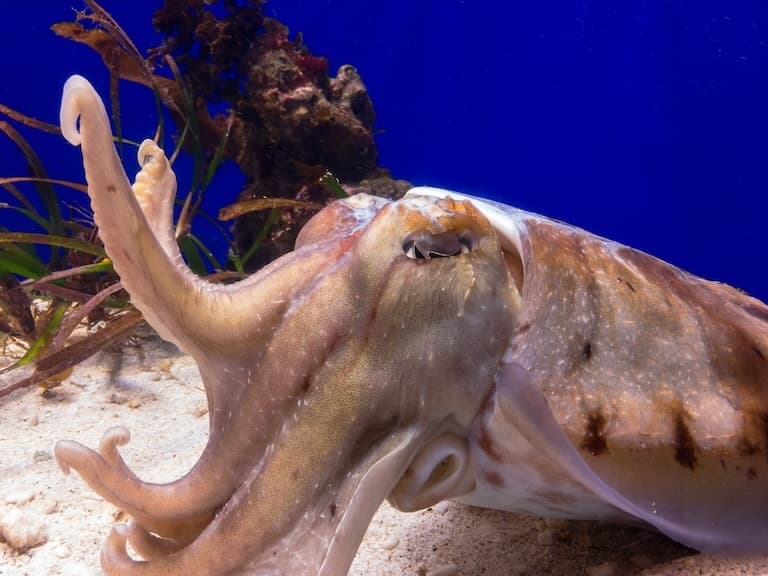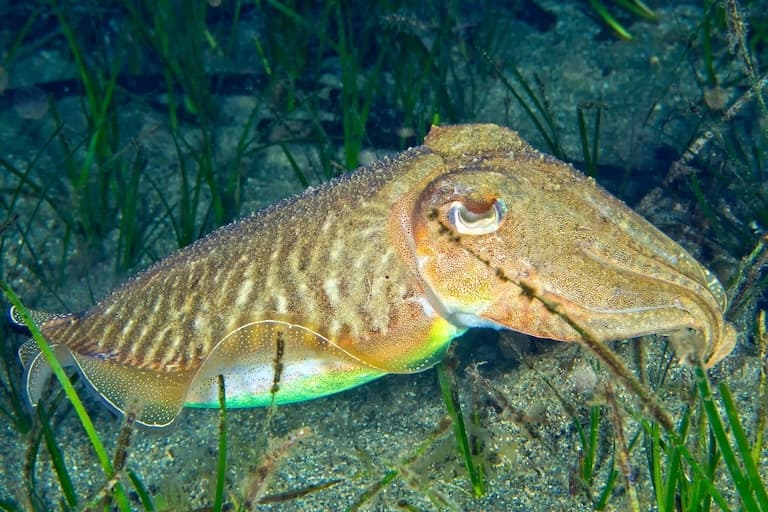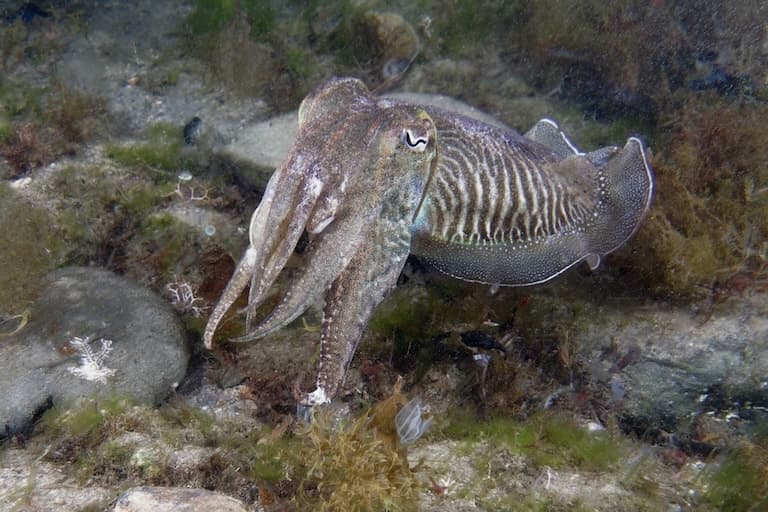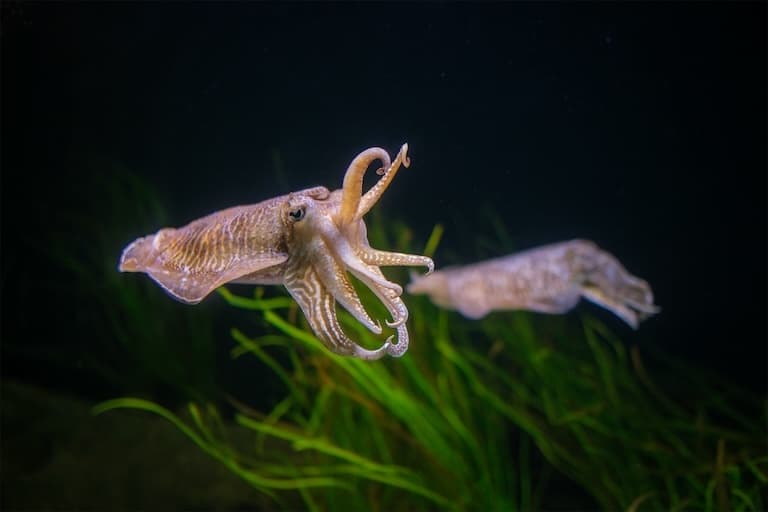Common Cuttlefish Profile
Cephalopods have a long and fantastic history, perhaps most notably culminating in the long dominance of the coiled-shelled ammonoids, who appear to have lived almost everywhere for around 350,000,000 years, occupying the upper 250 metres of the oceans, worldwide.
Their final form, the ammonites met an untimely end along with the majority of other species on Earth, around 66 million years ago, but the closest modern relatives of these shelled molluscs are not the similar-looking nautiluses, but the squishy octopus, squid and cuttlefish, and of the three, the cuttlefish retains the most of its ancestors’ shells – hidden inside its fleshy mantle.

Common Cuttlefish Facts Overview
| Habitat: | Marine, |
| Location: | Eastern North Atlantic, into the Mediterranean, North Sea |
| Lifespan: | 1 to 2 years |
| Size: | Up to 60cm (2 ft) long in the mantle, with short arms |
| Weight: | Up to 4 kg (8.8 lb) |
| Colour: | Varied, typically mottled black-brown base with variable patterning. |
| Diet: | Fish, molluscs, aquatic or marine worms, crustaceans |
| Predators: | Almost all larger predators: large fish, seals, sharks, dolphins and whales, humans |
| Top Speed: | Capable of short bursts of speed |
| No. of Species: | 1 |
| Conservation Status: | Least Concern (IUCN) |
It’s likely the survivors of the extinction event that killed the ammonites did so by sinking to the relative stability of the deeper ocean. To do this, they needed to evolve away from the buoyant, air-filled shells and into a softer-bodies phenotype that could handle this pressure.
After the fact, the shallow water became an open playground, free from competition, and species began to radiate back toward to surface.
Some of these species became the cuttlefish, and the common cuttlefish is one of the largest.
This incredible animal is one of the brightest in the ocean, and not just because of its sexy zebra mating stripes. Intelligent, voracious, and short-lived, the cuttlefish smashes convention in a way that only
Interesting Common Cuttlefish Facts
1. They’re shallow-water cephalopods
The asteroid that wiped out the dinosaurs also took with it the vast majority of all species on Earth, and the most affected were the terrestrial animals and those found in shallow waters.
But the ancestors of the cuttlefish likely survived because they had ditched their shells to explore the deeper reaches of the ocean. Deep oceans today have a temperature range of about 0 to 3 degrees Celsius, far less than the terrestrial air temperature range of around -25 °C to 45 °C or more.
Salinity also remains at around 3.5%, making it one of the most stable environments on Earth, and this is probably where modern cephalopods evolved while ancient ones like the ammonites didn’t survive.
After their demise, the ammonites left vast swathes of ocean niches unexploited, and as the climate recovered from the extinction event, ancestral cuttlefish migrated out of the darkness to take their place.
Today, the common cuttlefish is one of the shallow-water cephalopods, inhabiting a vertical range remarkably similar to their extinct cousins at around 200 meters and above.
They move up and down seasonally, spending spring and summer in the shallower waters and descending during the colder months as it gets colder.

2. They’re heavier in cold water
These are large cuttlefish, with mantle lengths of up to 60 centimetres, but there’s a distinct difference in size and weight between populations in subtropical and colder, temperate waters.
The warmer water populations range up to around 30 cm long, and weigh around a kilo, while the colder water populations can be double in both size and weight.
This is likely an adaptation to the cooler temperatures, as the larger body size will be able to maintain temperature across a wider thermal gradient than a smaller one would be.
3. They have shells
We mentioned that cuttlefish ditched their shells to explore the deep, but this is only partly true.
The chambered, buoyant coil of the modern Nautilus resembles what a lot of cephalopods would have been carrying around in the old days, and was adapted from the enormous, spire-like cone shells of their predecessors.
But the squishy-bodied octopus, squid and cuttlefish didn’t so much get rid of their shells, as much as they internalised them.
Octopus have the least amount left, showing up internally as a pair of stylets. Squid have a thin, translucent gladius, that runs along the inside of their mantle and gives their bodies rigitiy, and likewise, cuttlefish have an internalised organ, commonly called cuttlebone, and this is perhaps the most complex of the three.
Cuttlebone retains some of the buoyancy properties of the old chambered shells, being porous and spongy, and as such the animal can fill it with gases to help it move vertically through the water. It’s also rigid for helping the cuttlefish with locomotion.
Of course, this comes at the same cost that the ammonites experienced – a lack of depth. Cuttlebone implodes at depths of around 200 to 600 metres, depending on the species.
At one end of the mantle is a head, with large eyes and eight arms. The two long appendages are its paired tentacles, and these are what make the animal so scary if you’re a shrimp. 1

4. They’re predators
Cuttlefish look like adorable hovercars made of jelly. Their enormous eyes and gesticulating arms give them a particular charisma as long as you’re larger than they are, but if you’re not, this visage is one of a terrifying alien death cruiser, capable of advanced stealth technology and lightning-fast attack suckers.
Cuttlefish are top predators for their size and feed on more or less anything they can grab with their incredible tentacles. They’ll even eat each other on occasion, and they have two main modes of attack when hunting.
The first is to patrol the water slowly, tentacles pressed together under the head like a preacher, deep in thought. When in range, these paired, suckered tentacles shoot forward and grab their victim, dragging it back to the beak to eat.
The other is used for larger or hard-to-manipulate prey and involves a cat-like pounce and all available arms. These are expert hunters, and they start early.
5. They’re incredibly intelligent
“Intelligence” is a term that might slide in the animal blogging world but is a bit of a dirty word in animal behaviour science.
That’s because it doesn’t really mean a single thing. You can have street smarts but be terrible at arithmetic; or conversely, you can be an Oxford grad and still end up implicated in a “Piggate” scandal. The same is true in animal behaviour.
We often are biased toward “intelligence” that resembles our own, and this makes studying it difficult, but with that in mind, there are some elements of cognition that have really granted cephalopods a high ranking among researchers, and cuttlefish, while perhaps outshone by the more charismatic octopus, can really hold their own in this regard.
The cephalopod equivalent of the Stanford marshmallow test – something which 4-year-olds fail, and even adults of the TikTok generation demonstrably struggle with – proved that cuttlefish have self-control, and can appreciate the concept of delayed gratification.
Like in humans, individuals showed differences in their ability to pass these tests, and these differences corresponded with their success in learning tests, too. Faster learners had more self-control, while many of the slower ones spent all their money on NFT scams.
Two of the test subjects flat-out refused to take part, showing an even higher level of smarts.
By now, it’s hardly surprising that cuttlefish are this clever, but what is strange is that they evolved totally independently of the mammals, whose last common ancestor with cuttlefish was back when everything was just worms, more than 600 million years ago.
Another study suggested that even while still encased in their translucent egg sacs, the embryos use their advanced eyesight to learn about their future prey. Hatchlings that observed crabs while they were maturing inside the egg showed a preference for them as prey items later on.
So, cuttlefish can learn from their environment and from one another, but unlike us apes, cuttlefish don’t have speech. Instead, they communicate their ideas using light. 2

6. They’re incredible flashers
For such a solitary species, the literature defines the ‘culture’ of this species in reference to its captive rearing for food, rather than its societal behaviours, but cuttlefish do come together, at least to mate. In fact, they’re substantially more social than octopuses.
Cuttlefish have both reflexive and conscious ability to change colour, and we are still trying to tease apart the nature of their communication. Pairs of cuttlefish can be seen flashing at one another, strobing at various frequencies until they come into synchrony, apparently sharing information.
This is a truly alien form of “talking” and there’s a good chance we’ll identify a lot of weird and amazing qualities around it in the years to come. 3
7. Live fast, die young
A characteristic and tragic trick of nature is the lack of longevity in such intelligent animals as cephalopods. Cuttlefish are no exception, and from the moment of birth, they are voracious feeders, growing up fast, mating as soon as possible and then dying.
The entire lifecycle of such an animal can be as little as a year or two, seemingly a waste of exceptional brains, but still a significant contributor to the ecosystem as a whole. 4
Common Cuttlefish Fact-File Summary
Scientific Classification
| Kingdom: | Animalia |
| Phylum: | Mollusca |
| Class: | Cephalopoda |
| Order: | Sepiida |
| Family: | Sepiidae |
| Genus: | Sepia |
| Species: | officinalis |
Fact Sources & References
- Samantha Andrews, “Sea Shorts: The curious case of the cuttlefish bone”, Ocean Oculus.
- “Cuttlefish show their intelligence by snubbing sub-standard snacks”, University of Cambridge.
- “Cephalopods”, The Animal Communication Project.
- Ae Lin Compton, “Sepia officinalis”, Animal Diversity Web.
